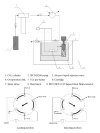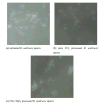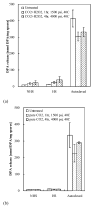Supercritical carbon dioxide and hydrogen peroxide cause mild changes in spore structures associated with high killing rate of Bacillus anthracis
- PMID: 17628729
- PMCID: PMC2084089
- DOI: 10.1016/j.mimet.2007.05.019
Supercritical carbon dioxide and hydrogen peroxide cause mild changes in spore structures associated with high killing rate of Bacillus anthracis
Abstract
The present work examines chemical and structural response in B. anthracis spores killed by a mixture of supercritical carbon dioxide (SCCO(2)) and hydrogen peroxide (H(2)O(2)). Deactivation of 6-log of B. anthracis spores by SCCO(2)+H(2)O(2) was demonstrated, but changes in structure were observed in only a small portion of spores. Results from phase contrast microscopy proved that this treatment is mild and does not trigger germination-like changes. TEM imaging revealed mild damage in a portion of spores while the majority remained intact. Dipicolinic acid (DPA) analysis showed that <10% of the DPA was released from the spore core into the external milieu, further demonstrating only modest damage to the spores. Confocal fluorescent microscopy, assessing uptake of DNA-binding dyes, directly demonstrated compromise of the permeability barrier. However, the magnitude of uptake was small compared to spores that had been autoclaved. This work suggests that SCCO(2)+H(2)O(2) is quite mild compared to other sterilization methods, which has major implications in its application. These results provide some insight on the possible interactions between spores and the SCCO(2)+H(2)O(2) sterilization process.
Figures







Similar articles
-
Sterilization of bacterial spores by using supercritical carbon dioxide and hydrogen peroxide.J Biomed Mater Res B Appl Biomater. 2007 Feb;80(2):511-8. doi: 10.1002/jbm.b.30625. J Biomed Mater Res B Appl Biomater. 2007. PMID: 16838346
-
[Sporicidal activity of hydrogen peroxide and peracetic acid against Bacillus anthracis spores].Med Dosw Mikrobiol. 2005;57(4):437-42. Med Dosw Mikrobiol. 2005. PMID: 16773838 Polish.
-
Studies on the mechanism of killing of Bacillus subtilis spores by hydrogen peroxide.J Appl Microbiol. 2002;93(2):316-25. doi: 10.1046/j.1365-2672.2002.01687.x. J Appl Microbiol. 2002. PMID: 12147081
-
Review of techniques for the in-situ sterilization of soil contaminated with Bacillus anthracis spores or other pathogens.Res Microbiol. 2024 May-Jun;175(4):104175. doi: 10.1016/j.resmic.2023.104175. Epub 2023 Dec 21. Res Microbiol. 2024. PMID: 38141796 Free PMC article. Review.
-
Review of Decontamination Techniques for the Inactivation of Bacillus anthracis and Other Spore-Forming Bacteria Associated with Building or Outdoor Materials.Environ Sci Technol. 2019 Apr 16;53(8):4045-4062. doi: 10.1021/acs.est.8b05274. Epub 2019 Apr 2. Environ Sci Technol. 2019. PMID: 30901213 Free PMC article. Review.
Cited by
-
The Synergistic Effect of High Pressure CO2 and Nisin on Inactivation of Bacillus subtilis Spores in Aqueous Solutions.Front Microbiol. 2016 Sep 21;7:1507. doi: 10.3389/fmicb.2016.01507. eCollection 2016. Front Microbiol. 2016. PMID: 27708639 Free PMC article.
-
Application of supercritical fluid carbon dioxide in improving food shelf-life and safety by inactivating spores: a review.J Food Sci Technol. 2022 Feb;59(2):417-428. doi: 10.1007/s13197-021-05022-7. Epub 2021 Feb 16. J Food Sci Technol. 2022. PMID: 35185167 Free PMC article. Review.
-
Investigating the Inactivation Mechanism of Bacillus subtilis Spores by High Pressure CO2.Front Microbiol. 2016 Sep 7;7:1411. doi: 10.3389/fmicb.2016.01411. eCollection 2016. Front Microbiol. 2016. PMID: 27656175 Free PMC article.
-
Treatment of clinical solid waste using a steam autoclave as a possible alternative technology to incineration.Int J Environ Res Public Health. 2012 Mar;9(3):855-67. doi: 10.3390/ijerph9030855. Epub 2012 Mar 9. Int J Environ Res Public Health. 2012. PMID: 22690168 Free PMC article.
-
Mechanism of Bacillus subtilis spore inactivation by and resistance to supercritical CO2 plus peracetic acid.J Appl Microbiol. 2016 Jan;120(1):57-69. doi: 10.1111/jam.12995. Epub 2015 Dec 9. J Appl Microbiol. 2016. PMID: 26535794 Free PMC article.
References
-
- Arzese A, Skerlavaj B, Tomasinsig L, Gennaro R, Zanetti M. Antimicrobial activity of SMAP-29 against the Bacteroides fragilis group and clostridia. J Antimicrob Chemother. 2003;52:375–381. - PubMed
-
- Dempsey DJ, Thirucote RR. Sterilization of medical devices: A review. Journal of Biomaterials Applications. 1989;3:454–523. - PubMed
Publication types
MeSH terms
Substances
Grants and funding
LinkOut - more resources
Full Text Sources
Other Literature Sources

